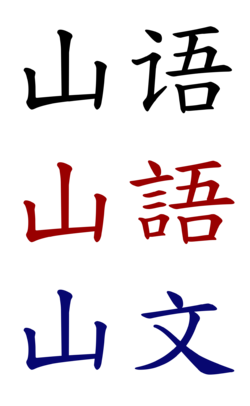Monsilvan language
| Monsilvan | |
|---|---|
| |
| Native to | Monsilva, parts of Byasa and Baltanla |
| Ethnicity | Monsilvans |
Native speakers | 65 million (first language) 115 million (total) (2022) |
Byasa-Silvitic
| |
Early form | Proto-Shan †
|
| Dialects |
|
| Monsilvan characters (Pinyin) | |
| Official status | |
Official language in | |
Recognised minority language in | |
| Language codes | |
| ISO 639-1 | Ms |
| ISO 639-2 | Msn |
| ISO 639-3 | Msn |
The Monsilvan language (山文 pinyin: Shānwén) is the largest member of the Byasa-Silvitic language family and therefore also the largest member of the Shan branch. It is spoken natively by the ethnic Monsilvan majority and some minority groups living in Monsilva. About 65 million people speak standard or a dialect of Monsilvan as their first language, and around 50 million people speak Monsilvan as a second, third or higher language. Monsilvan is one of ROKO and the Ostlandet Union's many official languages.
The earliest Monsilvan written records are pre-Xia dynasty Oracle bone script oracle bone inscriptions, which can be dated to 1250 BCE. The phonetic categories of Shan can be reconstructed from the rhymes of ancient poetry. Soon after the Unification of the Monsilvan Kingdoms, Shan went through several sound changes and evolved gradually overtime. After the establishment of the Kingdom of Great Shan, Monsilvan literature and writing became hugely more popular and lead to the wipe out of many lesser-known languages still spoken in the kingdom. By the early 19th century, almost all other members of the Silvitic language family had become extinct and Standard Monsilvan (and its dialects) had become widely known.
Monsilvan uses two scripts which are very similar to each other. The first script is known as "Traditional Shan script", and is the original script used throughout most of Monsilvan history until 1980. The second script very similar but features some simplifications making certain characters look slightly less complicated than their traditional counterparts. This script is called "Simplified Shan script". It is commonly found in handwritten and digital text. In Standard Monsilvan, traditional writing is usually only found in logos and in stylized contexts. Both scripts are also used in Luhainese, another member of the Silvitic languages, and is also under the Shan branch, which is spoken in northern Monsilva in the states of Luhai, Leibo and Meixian. Traditional script is much more common in Luhainese, and is still used in digital format.
Standard Monsilvan is based off the original dialect that was spoken in the current capital of Monsilva, Amking. It was officially established in 1912 as the official language/dialect of the Kingdom of Monsilva and has remained that way ever since.
Monsilvan is recognized as a minority language in Byasa and Baltanla. This is due to each of the nations having a noticeable Monsilvan population who have brought the language over hundreds of years of history.
